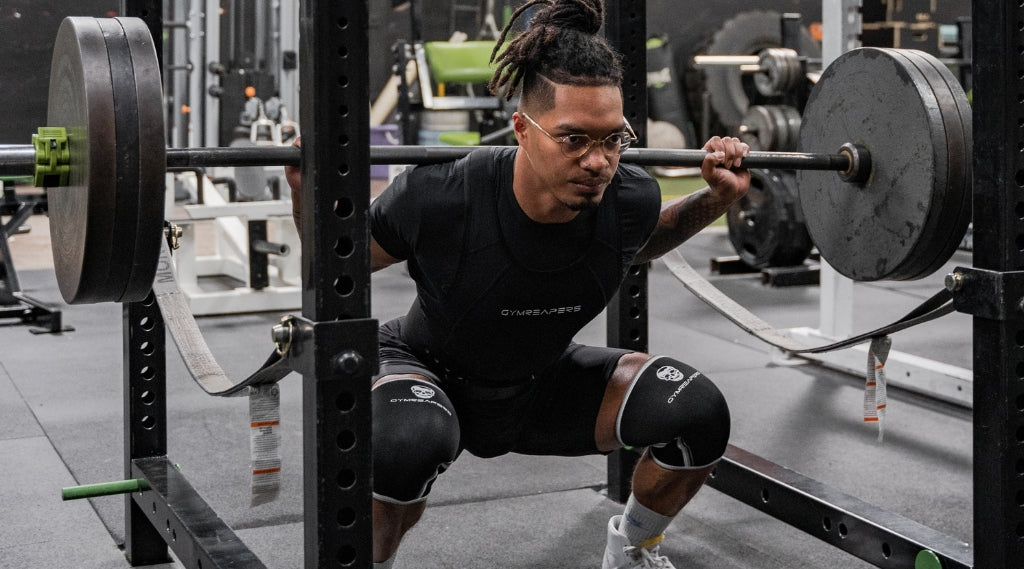As a personal trainer with years of experience, part of my job has been to educate my clients on whether to train with free weights and/or resistance bands.
The main difference between bands and free weights is the type of resistance they provide. Bands offer constant tension and increasing resistance as the band stretches, resulting in greater peak contractions. In contrast, free weights offer the same resistance throughout the entire movement and have a relaxation point.
Understanding how these differences in resistance will impact your results is important so that you can determine whether bands or free weights are better or if you should be using both.
Key Takeaways
Differences Between Resistance Bands & Free Weights

To understand whether bands or free weights are better, it’s important to understand how they differ.
Free weights (barbells, dumbbells, and kettlebells) provide the same level of resistance from start to finish.
With free weights, you can lift as much as you want based on what you have access to and how much you’re able to lift.
Both bands and free weights are valuable tools that offer unique benefits, which we’ll dive into next.
Resistance Bands

Resistance bands are long pieces of elastic material designed for physical activity.
The main types are:
-
Loop bands, which are typically flat and made of latex. These go around in a continuous loop and are ideal for warming up, doing mobility work, and working out.
- Open-ended bands, also known as tube bands. These generally have handles attached to both sides and are designed for compound and isolation exercises like bicep curls, lateral raises, overhead presses, etc.
- Hip bands, also known as mini or booty bands. These also go around in a continuous loop but are smaller and designed to be wrapped over the thighs or lower legs for exercises like lateral leg raises, donkey kicks, lateral walks, etc.
Benefits
The benefits of training with resistance bands include:
- Bands allow you to do various exercises to warm up, improve your mobility, build strength, and gain muscle
- You can use a loop band to make bodyweight exercises easier or more challenging; for example, do band-assisted pull-ups if you lack the strength for the unassisted version
- Bands offer different levels of resistance, which makes them useful for beginners and advanced lifters alike
- Bands have linear variable resistance (LVR), which means the tension they provide increases as they lengthen, making the top of each repetition more challenging
- Similar to cable machines, bands offer constant tension, which, in combination with LVR, can result in stronger muscle contractions and better mind-muscle connection
- Bands are affordable and compact, which makes them the ideal workout tool for people who exercise at home; for example, the Military five-band set from Gymreapers only costs $75.99
- Bands are light and compact bands, so you can take them with you when traveling for fun and effective hotel room or outdoor workouts
Drawbacks
The drawbacks to training with resistance bands are:
- Bands from generic bands are more likely to break or snap after a while
- The resistance you get from bands increases as they stretch, which means the bottom of each repetition will feel easy and won’t challenge your muscles in that range of motion.
- It can take trainees a while to get used to performing certain exercises with bands if they are used to the even resistance from cable machines and free weights
- Tracking your performance and progress on resistance band exercises can be trickier because the band resistance isn’t constant.
- Although some bands can offer up to 150 lbs of resistance, there is a progression limit, which can be problematic for more advanced trainees
Who Should Use Them
Resistance bands are ideal for:
- Those who need a new stimulus to overcome a plateau or avoid staleness.
- Those who are new to resistance training.
- Those working out at home or while traveling.
- Those who want to improve muscle activation before training.
- Those who want to work on their mobility.
Free Weights

Free weights are training equipment not attached to a machine or frame. You can freely pick them up and lift them in any direction you choose.
The most popular free weights include:
-
Barbell - a long metal shaft with sleeves on both ends for weight plates
-
Bar - a short version of a barbell that weighs less and is suited for isolation exercises like bicep curls
-
EZ bar - similar to bars, but curved to resemble a wide letter ‘W’ for wrist comfort during curls, tricep extensions, etc.
-
Dumbbell - a short metal bar with weights on both ends; dumbbells can also be adjustable, which means trainees can change the weight to suit their needs
-
Kettlebell - a metal ball with a handle on top; like dumbbells, kettlebells can also be adjustable
-
Weight plates - flat disks made of different materials (most commonly metal) used in combination with barbells and adjustable dumbbells
Benefits
The benefits of free weight training include:
- Free weights are incredibly versatile, as trainees can lift light or heavy, do countless exercises, and manipulate the tempo to emphasize muscle gain, power development, etc.
- Performing free-weight exercises is an effective way to activate and strengthen the stabilizing muscles, promoting whole-body stability
- Compound lifts with free weights allow trainees to target multiple major muscle groups simultaneously and load them more efficiently
- Free weights make it easy to progressively overload your muscles (i.e., make your workouts more challenging), as it is easy to monitor progress by writing down variables like load used, reps done, and number of sets
- Free weights develop grip strength, which is beneficial in training and everyday life
Drawbacks
The drawbacks of free weight training include:
- Free weights tend to pose a greater risk of injury because there is a higher potential for user error
- It’s generally best to have a spotter around when attempting to lift heavy weights, which might not be possible for people working out at home
- Trainees find it more challenging to use free weights as they require more skill to maneuver, especially on compound lifts (bench, squat, deadlift, etc.)
- Maintaining stability while lifting free weights is more challenging, especially for beginners
- Free weights are more intimidating for inexperienced lifters, who tend to shy away and gravitate toward ‘safer’ options like gym machines, cardio equipment, and bodyweight movements
- For those interested in building home gyms, free weights are more expensive to get (even second-hand) and take up more space
Who Should Use Them
Despite some shortcomings, free weights are a fantastic option for almost everyone, but they’re particularly beneficial for:
- Those who want to improve their health (i.e. heart health, bone strength, mental health)
- Those who want to build muscle
- Those who want to get stronger
- Those who want to lose fat (would also require a calorie deficit)
- Those who want to improve their athleticism
Should You Use Resistance Bands And Free Weights?

You can and should use free weights and resistance bands in your training program to get the best of both worlds.
You can include resistance bands and free weights into your training routine by:
- Training with bands some days and free weights others
- Training compound movements with free weights and isolation movements with bands
- Warming up with bands and using free weights for the workout
- Performing your working sets with free weights and adding a burnout set with bands
- Adding bands to your free weights to increase the resistance at the top end
Resistance Band Recommendation

The Military Resistance Band Set by Gymreapers is my top recommendation because they are perfect for warming up, mobility exercises, and strength and hypertrophy training.
This set includes five bands, each covering a specific tension range:
- Desert Tan: 20-35 lbs.
- OD Green: 30-60 lbs.
- Dark Earth: 40-80 lbs.
- Ranger Green: 50-120 lbs.
- Coyote Brown: 60-150 lbs.
The thinner ones are best for isolation exercises and warm-up activities. In contrast, Dark Earth, Ranger Green, and Coyote Brown work great for strength activities: lat pulldowns, horizontal rows, overhead presses, deadlifts, banded squats, and more.
You can also use two or more bands to get the resistance you need.
For example, if you want to do band deadlifts and Coyote Brown isn’t enough, combine it with Ranger Green and Dark Earth to bump the resistance to 350 lbs.
Weight Recommendation 
Kettlebells are incredibly versatile, and even a single one can be enough for you to do multiple exercises to strengthen and develop most major muscle groups in your body.
Take one 14-kilo (31 lbs) kettlebell as an example. With it, you can do traditional gym activities like:
- Bent over rows
- Upright rows
- Goblet squats
- Overhead presses
- Tricep extensions
- Front raises
- Floor presses
- Romanian deadlifts
You can also use kettlebells for more dynamic activities like:
- Swings
- Thrusters
- Snatches
- Clean and presses
- Sumo high pulls











Hinterlasse einen Kommentar
Alle Kommentare werden vor der Veröffentlichung geprüft.
Diese Website ist durch hCaptcha geschützt und es gelten die allgemeinen Geschäftsbedingungen und Datenschutzbestimmungen von hCaptcha.